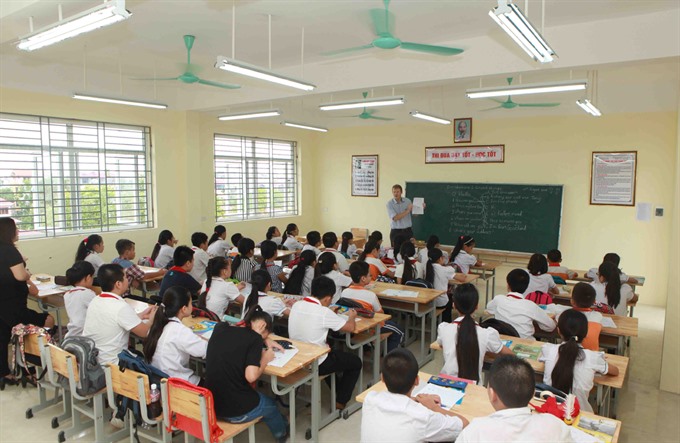 Society
Society

Many apartment buildings have shot up in Hà Nội over the past several years, leading to a huge population increase. However, the construction of basic facilities like schools has been ignored or carried out slowly.
 |
| A classroom in Thụy Phương Secondary School in Hà Nội’s Bắc Từ Liêm District. The construction of basic facilities like schools has been ignored or carried out slowly in Hà Nội in recent years. VNA/VNS Photo Quý Trung |
HÀ NỘI – Many apartment buildings have shot up in Hà Nội over the past several years, leading to a huge population increase. However, the construction of basic facilities like schools has been ignored or carried out slowly.
This has concerned parents as they have no choice but to send their children to private schools, often with expensive tuition fees.
Lê Hằng, resident in HH3B Apartment in Linh Đàm Urban Area, said that she had to send her son to private pre-school as Hoa Hướng Dương pre-school, the only public one in the area, was overloaded.
“Linh Đàm urban area is quite large with many buildings, but there are few public schools here. I have to send my kid to a private school,” she said.
Dương Thị Liên, resident in Rice City Linh Đàm Apartment was luckier. She managed to get child into Hoàng Liệt Primary School, the only public primary school in the area. However, she was concerned about the high number of students – 57 per class –affecting her child’s education.
The situation is the same in other urban areas like Nam Từ Liêm and Hoàng Mai districts.
Chairman of Mễ Trì Ward’s People’s Committee in Nam Từ Liêm District, Đào Tăng Quýnh, said that more than 4,000 households were living in apartment buildings in the ward, and this number would increase by 3,000 households when three more apartment projects were put into use.
However, no new school has been set up in the last few years. About 60-65 children were crammed into some classrooms and secondary students have to use temporary classrooms, he added.
Nguyễn Thị Thái, deputy chairwoman of Đại Kim Ward’s People’s Committee in Hoàng Mai District agreed, saying that there were only two public pre-schools, a primary school and a secondary school.
Students at primary and secondary schools were forced to go to school at weekends due to a shortage of classrooms, she said.
The current population of the ward is currently about 36,000 and will rise when three more apartment buildings were put into use by the end of this year.
Figures from the city’s Department of Education and Training showed that there were 252 apartment buildings in the city, and most approved projects included the construction of new schools. But only 56 schools have been built.
Government policy dictates a maximum of 35 students per primary class, but no schools in new urban areas have achieved this target.
Meanwhile, many school construction projects have been implemented slowly.
In Hoàng Mai District, 96 school building projects have been approved. Of these, 33 have not been handed to investors and 46 have not carried out site clearance.
The reason was a shortage of land funds. Many projects were located in cemeteries, causing difficulties in clearing sites while investors, mostly private enterprises, faced shortages of investment capital.
To solve the problems, local authorities have examined the delayed projects and proposed city assign local authorities as investors to boost the progress of the projects.
The People’s Committee of Cầu Giấy District said they have taken a project for building a secondary and high school back and will build it in Yên Hòa Ward. It has proposed the city build two more schools in the upcoming time.
In Hoàng Mai District, the committee has asked the city’s permission to build 10 schools with State funds. -- VNS




